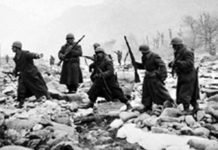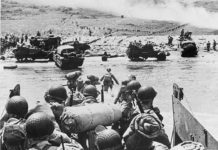The United States Navy built and maintained more 50 battleships over a 100-year period in 3 distinct types.
When the USS Wisconsin came off the builder’s docks in 1943, her pennant number was BB (Battleship) number 64, or more compactly BB-64. Her and her three Iowa-class sisters were the most advanced battleships in the world and were only finally decommissioned in 1991. What were the other 50-odd “BBs” that the US Navy had over the course of 100-years?
Early “Predreadnoughts”
Between 1890 and 1910, 28 US ships were classified battleships. These ships were all of more or less the same broad design with four main guns carried in two currents, one forward and one aft. A large number of smaller secondary and tertiary guns were casemated across the beams on each side. Torpedo tubes, themselves a new invention at the time, were also fitted to these ships but never used in combat. These battleships were all between 10,000-16,000 tons and could make 16-18 knots at top speed on their coal-powered plants.
The final designs of this era were the stopgap pair of USS South Carolina (BB-26) class battleships, which carried more than twice the main armament of prior US-designs, 8 12-inch guns. However, at only 16,000-tons these ships were too slow and wet for fleet use and spent their life as training ships. With the rest of these 28 ships few saw combat other than in isolated Spanish-American War engagements. They did however make up the bulk of the Great White Fleet in 1908 that made the epic circumnavigation around the world that introduced the US as a major sea power. These two- and three funnel ships were immortalized as the battleship piece in the Monopoly Game. Sadly they were all retired and either sunk, sold or scrapped. By 1956 the last had disappeared.
Dreadnought Battleships
Beginning with the USS Delaware (BB-28) in 1907, the US navy emulated the design of the HMS Dreadnought launched the year before. Over the next 16 years, 21 US all-large-gun fast battleships came off the lines in no less than seven progressively improved classes. Ranging from 22,000-32,000 tons and carrying between 8 and 12 large guns, the ships could all break 21-knots top speed, many using oil-fired rather than coal plants. Early designs carried 12-inch guns but this soon gave way to 14 and finally 16-inch guns, the largest in the world at the time. They were almost twice the size as the previous type of battleships, not to mention much faster and better armed.
With the end of World War 1, the destruction of the German High Seas Fleet and the Naval Treaties of the 1920s, many battleships (all numbers between BB-49 and BB-54) and a new class of battlecruisers were scrapped while still on the drawing board. When the USS West Virginia (BB-48) was completed in 1923, she would be the last new battleship for the US Navy for nearly two decades.
These ships formed the backbone of the US Navy up until the attack on Battleship Row on December 7 1941 in Pearl Harbor damaged or sunk eight of them, crippling the American striking power in the Pacific, and forcing the US to relay on carrier air wings, submarine warfare and fast cruisers. The USS Arizona (BB-39) was a total loss and today her wreckage is maintained as a shrine.
Resoundingly however six of these battleships, West Virginia, Maryland, Mississippi, Tennessee, California, and Pennsylvania (five of whom had been sunk at Pearl Harbor and raised), fought the last battleship-on-battleship fight against the Japanese battlewagons Yamashiro and Fuso, October 25, 1944 in the Battle of the Suriago Strait. While others such as the Arkansas and Texas were influential in the Atlantic carrying out shore bombardments. Today, only the USS Texas, preserved as a museum ship since 1948, still remains as the sole survivor of these ships.
Modern Battleships
When the $76-million USS North Carolina (BB-55) was ordered in 1937, she was the first new battleship construction since the WWI-era programs were suspended due to the Washington and London Naval Treaties. Ultimately, 10 large, thoroughly modern battleships of the North Carolina, South Dakota and finally Iowa-class were completed over the next six years. Weighing from 38,000-tons for the earlier ships to 45,000-tons for the later, these ships were all designed with nine powerful 16-inch guns, modern damage control; all-oil fired boilers, aircraft complements, and could outrun and outgun any other WW1-era battleship afloat. Most importantly, they had radar and enormous anti-aircraft defenses (149 anti-aircraft guns in the Iowa’s alone). These ships did not carry torpedo tubes and much of the elaborate ornamentation of the previous US-designs
The only battleship engagement these modern ships fought was the one-sided engagements between the Vichy French battleship Jean Bart and USS Massachusetts (BB-59) in Casablanca and the Japanese battleship Kirishima vs. the USS Washington (BB-56) in the Pacific. Their main contribution was in shore bombardment and fleet anti-air defense.
Most of these modern battleships have been saved as museum ships with few exceptions, the Iowa class only retiring finally after almost fifty years of service in the 1990s.








